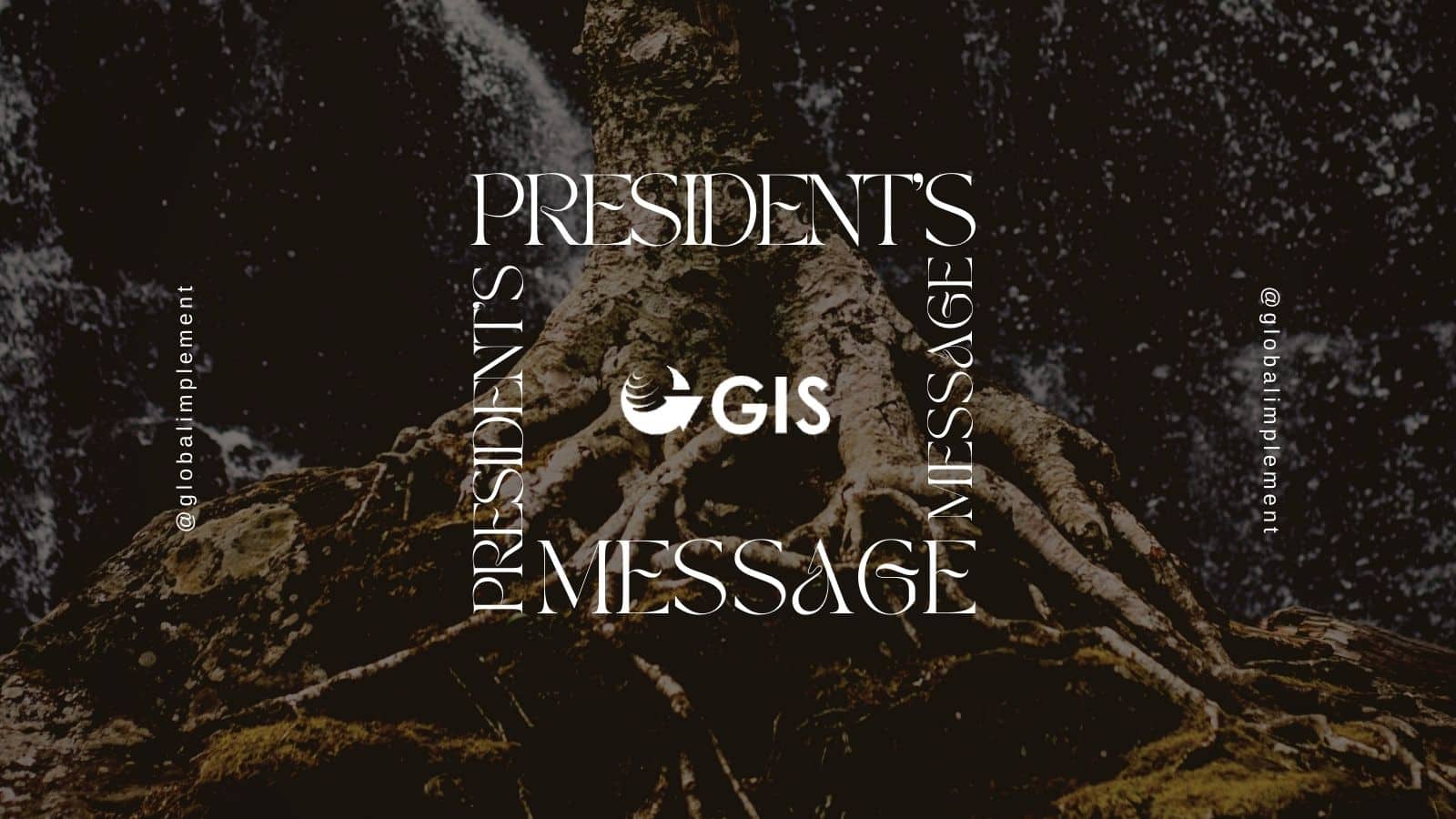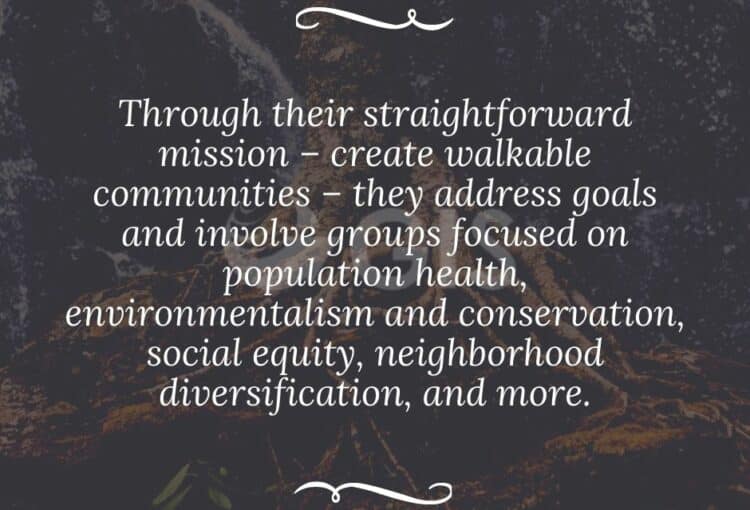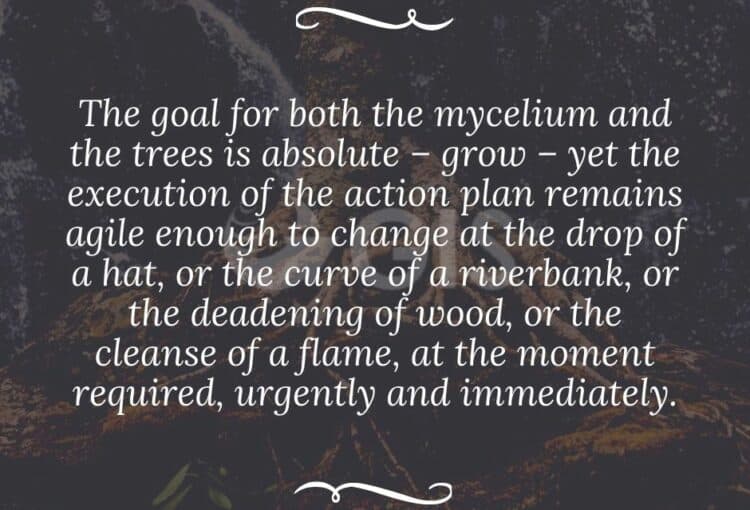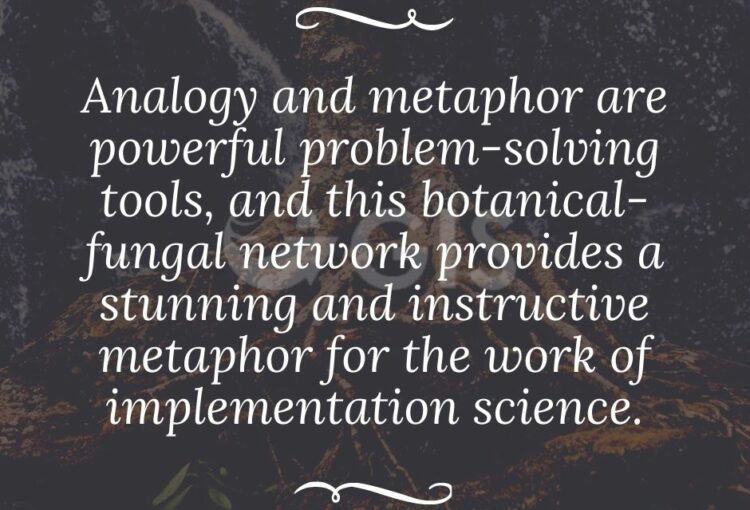President’s Mesage – A ‘Mycorrhizal’ Network


Hello GIS colleagues,
In this month’s newsletter, I am pleased to share with you the insights and intelligence of our GIS Administrative Support Team. Inspired by GIS’s implementation work, Zach McElgunn, professional education director, has been invited to share his thoughts about the lessons we learn from the diversity and ingenuity of this planet’s life. I hope you our nourished by this contribution from our colleague, and perhaps, you will find a seed of insight that will connect and grow to support your implementation efforts. – Melissa
Taking Inspiration from the "Wood Wide Web"
A 2014 article published by BBC Earth (since archived) entitled “Plants Talk to Each Other Using an Internet of Fungus,” discusses the processes and impact of the “mycorrhizal network,” an underground tapestry of fungus and plant roots connecting the world’s flora. The author explores the ways in which mycelium – the web of thin threads that make up bodies of fungi – move water, carbon, nutrients, and information between plants using the pithily named “Wood Wide Web.”
Through microscopic mycorrhizal threads, woven among diverse root systems, plants are able to alert one another to the presence of threats in the environment. Mycelium also have a positive effect on plant immune systems, “priming” a connected plant’s defenses against pathogens and parasites. There is even a kind of botanical altruism in the way plants – specifically trees – use the mycelium. Brawnier, older trees send nutrients and water through the mycelium to younger buds and saplings, helping them to survive despite lacking direct sunlight in the shade below the forest canopy.
So, why are you reading about complex botanical processes at the top of the GIS Newsletter?
Don’t worry, GIS is not transitioning away from implementation science to focus more heavily on botany… We are sharing this with you because of the ways in which plants and mycelium interact, because analogy and metaphor are powerful problem-solving tools, and this botanical-fungal network provides a stunning and instructive metaphor for the work of implementation science.[1]
Intertwined with the fungal threads connecting disparate root systems are lessons about how to promote the most effective and equitable solutions within our communities, and how to ensure that the policies framing our professional and political lives integrate the latest evidence without sacrificing the missions at their core.
The Symbiotic Power of Collaborative Goals
The first lesson we can learn from the mycelial carpet is the power of collaborative goals. Like so many symbiotic relationships in the natural world, both the mycelium and the plants benefit, as mycelium help the plants absorb nutrients and water more efficiently by giving the plant access to a greater amount of soil, and the plants “feed” the mycelium glucose and sucrose it creates through photosynthesis (which the mycelium would not be able to produce on its own).
Emphasizing their strengths – absorptive capacity and photosynthesis, respectively – both the mycelium and the plants are able to engage in a relationship that is not merely transactional. The further the mycelium extends through the forest, the more water, nutrients, and other plants a connected plant has access to; the healthier a plant grows, the more sucrose and glucose will be passed on to the mycelium entangled with its roots.
Put simply, this relationship is a win-win in the truest sense.
While we are not plants and fungi (though we do share DNA and common ancestry with the latter), we can and should seek to emulate the mutualism they embody. Indeed, many people and groups are doing so currently!
Consider the Congress for the New Urbanism, an international organization focused on creating walkable communities, and their The Charter of the New Urbanism, which seeks to blend “art of building, the making of community, and the conservation of our natural world.” Through their straightforward mission – create walkable communities – they address goals and involve groups focused on population health, environmentalism and conservation, social equity, neighborhood diversification, and more.
Another example of collaborative goal making is The United Nations Sustainable Development Cooperation Framework, which is the “most important instrument for planning and implementation of the UN development activities at country level,” as it outlines the principles underpinning coordination between the U.N. and member states in their mutual pursuit of the SDGs by 2030.
Despite our incredibly complex human systems, individual priorities, diverse opinions, and innumerable differences and similarities between one another, the power of collaborative goals and collaborative solutions continues to be borne out each day. We should take this lesson in collaboration and resource-sharing from the 1.1 billion year old relationship between fungi and plants.
Communication is Critical to Any Pursuit
The second lesson shrouded in this mysterious botanical process is that communication is central to any pursuit. Using mycelium to communicate threats and opportunities in the environment, plants are able to anticipate obstacles by staying in touch (literally) with one another. Anthropomorphizing the plants slightly, they benefit from one another’s “perspective,” almost as if a tree on one side of a forest can “see” the parasites and pathogens blowing in miles away on the other side.
With so many literal and figurative storms on the horizon, we would do well to emulate this sort of cooperative communication.
Many of us have experience with both good and sub-par communication, and we know that communication is multidirectional in a well-governed organization – both up the ladder and down the totem pole, and “laterally” among professional peers. As William Isaacs points out in his book, Dialogue and the Art of Thinking Together, when we communicate with one another we are engaged in generating shared meanings. These shared meanings are crucially important, as they are the foundations upon which our future actions are built.
Missions are Clarifying Lenses That Transcend Hierarchy
 A third and final lesson we can take from the mycorrhizal network is that the most effective missions are clarifying lenses which transcend hierarchy. There is no hierarchy in in the arrangement between the trees and fungi; the only governing factors are the limitations imposed by time. The goal for both the mycelium and the trees is absolute – grow – yet the execution of the action plan remains agile enough to change at the drop of a hat, or the curve of a riverbank, or the deadening of wood, or the cleanse of a flame, at the moment required, urgently and immediately.
A third and final lesson we can take from the mycorrhizal network is that the most effective missions are clarifying lenses which transcend hierarchy. There is no hierarchy in in the arrangement between the trees and fungi; the only governing factors are the limitations imposed by time. The goal for both the mycelium and the trees is absolute – grow – yet the execution of the action plan remains agile enough to change at the drop of a hat, or the curve of a riverbank, or the deadening of wood, or the cleanse of a flame, at the moment required, urgently and immediately.
With growth as a constant imperative, opportunities and “next steps” are quickly clarified. While it would be incredibly reductive to suggest that our goals are similarly black and white, there is something to be said for filtering decisions through the sieve of our individual and shared missions.
When we find alignment between our individual missions and those of our peers, we should strive to recreate the symbiosis of our fungal forebears. When we create rules and policies around personal, organizational, and societal conduct, we should ensure they are in accordance with missions we share.
GIS Can Strengthen Our Own 'Mycorrhizal' Networks
Each of us participating in GIS has the ability to help strengthen and sustain our own “mycorrhizal network.” Where fungi and plants benefit from one another’s access to ground water and sunlight, we have the opportunity to frame our pursuits more collaboratively, and in so doing make our efforts more potent and meaningful.
Where vegetation uses mycelium to transfer water, nutrients, and information, we have technology and dialogue to share perspectives, knowledge, and experience as we develop new innovations, solutions, ideas, analogies, and understandings.
Where fungi and plants can clarify actions with a straightforward mission of growth, we can clarify our actions with the more complex but no less useful missions of our organizations, and our own internal principles and sense of purpose.
We are a diverse and growing society of professionals, students, researchers, educators, policy-makers, and community members. I have no doubt that our future development – both for GIS and for our global community more generally – depends on our ability to integrate the perspectives, knowledge, experience, and expertise of those beyond ourselves.

Thank you for all you do to make this ambitious and necessary shared goal a reality.
Zach McElgunn,
Professional Education Director,
GIS Administrative Support Team
[1] Interestingly, this would not be the first time that trees and their mycelial network were used as an analogy for complex human system. From ARPANET, the internet’s predecessor developed by the US Department of Defense, to the human brain, where the “dendrites” that project from a nerve cell get their name from the Greek word for tree, the mycelial network beneath the forest floor is a persistent image used to understand complex systems.

